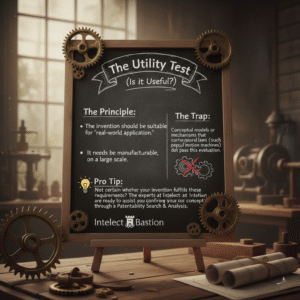Introduction: The “Eureka” Moment… Now What?
- You’ve made a discovery—a novel device, an accelerated software method or a chemical formula that might revolutionize the industry. However, before you hurry to the Indian Patent Office (IPO) or look up patent filing fees, in India you must address the question: “Can this truly be patented?”
- In India not all excellent ideas are eligible, for patent protection. The Indian Patents Act 1970 imposes criteria. Whether you are a startup founder or an R&D engineer this guide acts as your litmus test” to assess if you possess a patentable treasure or merely a strong concept that requires further development.
The "Golden Triangle" of Patentability
To obtain a patent your invention needs to meet three criteria. A failure, in any one of these will result in the patent examiner denying it.
The Novelty test (is it New)
The Guideline: Your invention should not have been disclosed, utilized or familiar to the public in any location prior, to your priority date.
The Pitfall: Have you uploaded a video on YouTube. Shared a whitepaper? If so you might have compromised your originality.
Task: Consider, “Is this available on Google within a journal or, at an outlet?
The Inventive Step Test (Is it Non-Obvious?)
The Principle: Your creation must not be apparent to someone “experienced in the field.” It should represent an innovation, rather, than merely a basic workshop tweak.
The Pitfall: Simple repositioning does not suffice. Attaching a flashlight, to a helmet cannot be patented. Nevertheless designing a helmet featuring an internal cooling system could be patentable.
Action Item: Consider whether a specialist, in my area would respond with ” course that’s simple ” or if they would find it unexpected.
The Utility Test (Is it Useful?)

- The Principle: The invention should be suitable for ” application.” It needs to be manufacturable, on a level.
- The Trap: Conceptual models or mechanisms that contravene laws (such, as perpetual motion machines) do not pass this evaluation.
- 💡 Pro Tip: Not certain whether your invention fulfills these requirements? The experts, at Intellect Bastion are ready to assist you in confirming your concept through a Patentability Search & Analysis.
Red Flags" (Section 3)
Despite your invention being original the Indian Patent Office will deny it if it is categorized under Section 3 of the Patents Act.
⚠️ The "Do Not Enter" List:
Frivolous Inventions: Violations of natural laws.
Scientific Principles: E=mc² is a discovery, not an invention.
Agricultural Techniques: A method of planting seeds cannot be patented (however a novel agricultural implement can be patented).
Medical Treatments: Surgical or therapeutic methods for humans/animals are not patentable in India.
Software (By Itself): Independent algorithms are frequently not accepted. Nonetheless software integrated within hardware that addresses an issue might qualify for a patent.
Interactive Self-Assessment
Take this quick mental quiz before contacting a patent attorney.

Essential prior Art Search Strategies
Prior to investing in patent filing services you should act like a detective. Conducting a “Prior Art Search” allows you to determine whether your invention is genuinely original.
The Keyword Search (The Basics)
Start with Google Patents or the InPASS (Indian Patent Advanced Search System) database. Use keywords describing the function of your invention.
Example: Instead of searching “Smart Helmet,” search “Helmet AND internal cooling AND sensor
The Citation Search (The Spiderweb Method)
Patents cite one another.
- Backward Citations: Discover the technologies the inventor utilized to develop their invention.
- Subsequent Citations: Discover who has built on that concept afterward.
The Inventor & Assignee Search (Competitor Analysis)
If you are aware that a rival (such, as “Tata Motors” or “Samsung”) operates within your sector conduct a search using the Assignee Name. This uncovers their projects even when they use ambiguous titles to conceal their technology.
The “Pro” Move: Professional Patentability Search
Optional, but Highly Recommended DIY searches serve as a “sanity check ” yet they have limitations. Free databases frequently overlook -English patents or very recent applications due, to the 18-month publication delay. Why hire a professional Patent Attorney?
- Subscription Databases: Specialists utilize paid resources (such, as Derwent or Orbit) that encompass patents.
- Eyes: We identify “concept duplication.” Even if nobody created your device a wide-ranging existing patent could still prevent you.
- Cost Saving: Spending a small amount on a professional patent search now can save you lakhs in wasted filing fees later
Conclusion: Don’t Navigate the Maze Alone
Obtaining a patent in India involves planning just as much as inventiveness. Knowing the environment prior, to submission distinguishes an approved patent from a denied one. If you have an idea and aren’t sure if it passes the “Novelty” or “Section 3” test, let the experts handle the research.
Request a Free Preliminary Assessment
Ready to move forward? Contact Intellect Bastion today for a consultation with our registered patent agents.





